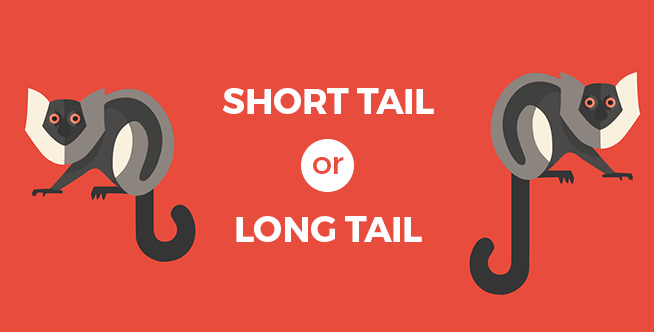.png)
.png)


















The first question you need to ask yourself is, what do you want to achieve? More visitors viewing your website or more visitors ready to buy from you?
The next thing you need to know is the different type of keywords available and which ones are the best to use for an effective SEO strategy. As a website owner and content creator, you want the keywords on your page to be relevant to what people are searching for, so they have a better chance of finding your content among the results. After you’ve done your extensive keyword research, finding the best keywords related to your business, you’ll have a list of short tail and long tail keywords which will make a good starting point.
Short tail keywords, or “head terms”, are search phrases containing 1 to 3 words. For example, “SaaS”, “SaaS products” and “SaaS products store”.
Long tail keywords are search phrases containing more than 3 words. These keywords make more than 70% of internet searches. A good example of a long tail keyword would be: “SaaS products store in UAE”, or “The best SaaS products store in UAE”.
If your goal is to drive a lot of visitors to your website, using short tail keywords is often the most effective way to do this. However, the challenge with short-tail keywords is that if you’re just starting out with a new website or have never done any SEO work before, you’ll be joining the back of a long queue.
Although short tail keywords would generate thousands of visitors to your website, they are highly competitive and harder to rank on Google. However, with a bit of hard work, patience and using the correct approach it is possible to rank for these search terms.
· High search volume
· High competition
· Low intent to purchase
· Low conversion rate
If you want more visitors to find what they are searching for and buy from you, long tail keywords are more descriptive and allow you to target your ideal customer more specifically.
The challenge with long tail keywords is that they are more specific. You’ll receive fewer visitors to your website compared to using short tail keywords, but the visitors you do acquire have a higher intent to purchase because they are searching for something specific.
Although the number of visitors will be lower, you’ll be more likely to convert your visitors into paying customers.
If you look at the long tail keywords examples again:
“SaaS products store in UAE”, or “The best SaaS products store in UAE”.
You can easily notice that customers are searching for a specific kind of store in a specific location / country. If your website is optimized for this phrase and is found on Google, your visitor will land on the exact page they were searching for and will more likely buy from you.
Compare this to a short tail keyword search. The visitor would land on a page optimized for “SaaS” or “SaaS products”. This could be any store or any freelancer selling SaaS products in any country, making the search less effective and a lower conversion rate.
· Low competition
· High intent to purchase
· High conversion rate
· Low search volume
The relationship between high cost and competition against the probability of conversion for short tail and long tail keywords is illustrated in the image below.
Long tail keywords make up 70% of Google searches, so the best approach is to optimize your website for long tail keywords but also include some short tail keywords.
This approach means that you can cover all the bases. You’ll be positioned high for long tail searches, capturing visitors with a high intent to purchase but you will also start to climb the ranks for short tail searches.
If you do have success with ranking short tail keywords this will improve your overall SEO and help your long tail keywords rank due to the increased traffic and higher click-through rates.
After all, having successful SEO of your website means that you have found the right balance of keywords that attracts prospective customers.